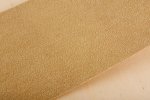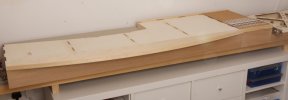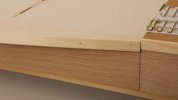RichardG
Western Thunderer
Yes it can be turned into a nice piece of furniture. With this in mind, and to match the pine edge mouldings have you used, have you considered using iron-on wood veneers for the fronts, outer ends, and rear of the baseboards to hide the ugly burnt (to me anyway) laser cut joints to finish the outer edges?
Wood Veneer 200mm
I have bought some American Oak veneer from Veneers Online, and applied it to the front and rear of the baseboard frame. This has rather transformed the good but bland birch plywood into something which, as you suggest, could resemble a piece of furniture.

The glue on this veneer has a coarse texture, in places like a honeycomb. When you melt it (domestic iron) I guess the hollows consume the surplus glue which doesn't penetrate into the substrate.

Truly I have never encountered a woodworking product which is so easy to use and which produces such a dramatic effect. The veneer is easier and quicker than paint, and about the same price if you have to buy fresh undercoat and gloss. The veneer also hides the laser-scorched tenons of the construction.
I wrapped the sole plate with kitchen foil to make sure I didn't transfer any dirt onto the veneer, and I used a moderate heat i.e. "cotton" rather than "linen".

Oak photographs much better than birch!
The wood grain of the pine mouldings is not particularly attractive. My current thinking is to paint these mouldings in satin black, and treat the veneer with a hard wax oil. This way I will end up with only two finishes, veneer and black paint; and the model will appear to be built on a slender baseboard resting on a deeper plinth. However I do wonder if a dark wood stain and more oil on the mouldings would be just as good? Staining and oiling is so much easier than painting.

 . Presentation is just one of those things I take my time over to ensure it looks right (my grandfather was a carpenter and builder). I never use black, brown or green paint as it has a propensity to scuff, look unsightly and untidy - which ultimately requires repainting to restore it's look. At least with varnished and stained wood, knocks and dents become part of the patina like a well used piece of furniture.
. Presentation is just one of those things I take my time over to ensure it looks right (my grandfather was a carpenter and builder). I never use black, brown or green paint as it has a propensity to scuff, look unsightly and untidy - which ultimately requires repainting to restore it's look. At least with varnished and stained wood, knocks and dents become part of the patina like a well used piece of furniture. . Full details are in my thread
. Full details are in my thread 





